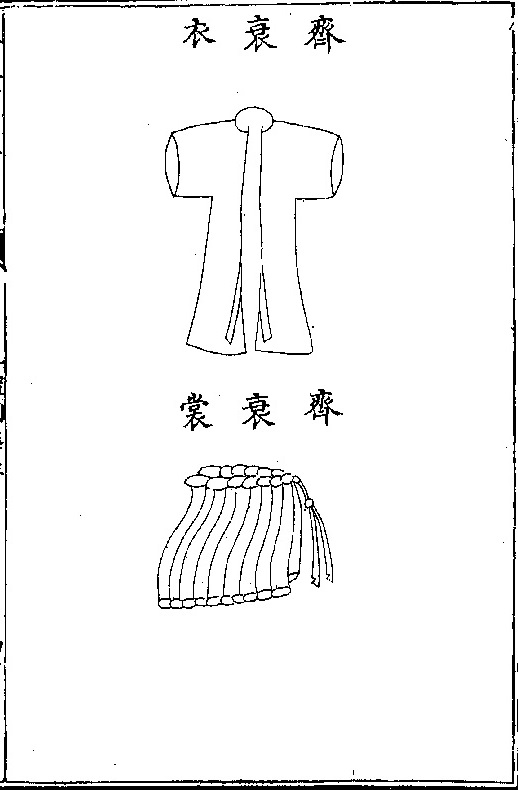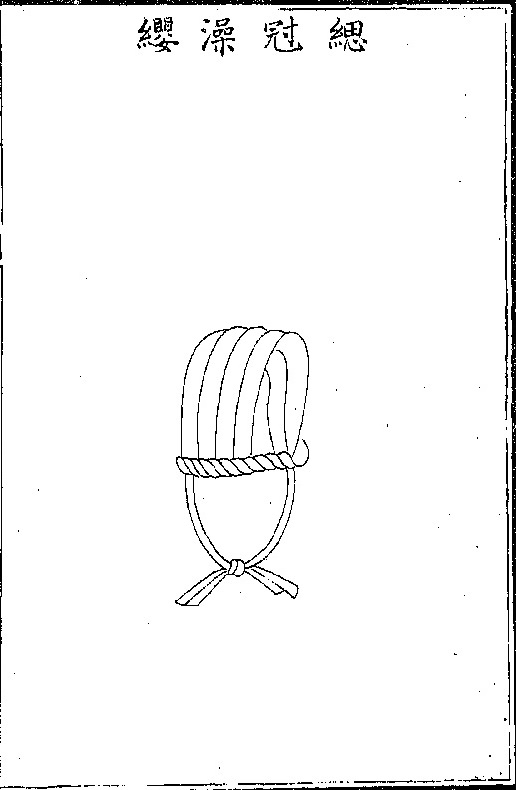The mourning dress (sangfu 喪服) was worn during funerals, in order to express filial piety (xiao 孝) after the passing away of one's parents or grandparents, or grief about the passing away of another relative or a lord.
A set of mourning clothes included robe (yi 衣, fu 服), headgear (guan 冠), sandals (xie 鞋, lü 屨), girdle (dai 帶), and a linen gown (mashan 麻衫, chang 裳), and differed according to the social distance to the deceased person.
Ancestral rituals as manifested in the social order of Confucianism knew five grades of relationship, expressed in five different styles of mourning clothes (wufu 五服), namely:
| zhancui | i.e. cui 縗, being a square piece worn before the breast | |
| qicui | 齊衰 | also written 資, i.e. zi 𪗋 the seam of underwear |
| dagong | 大功 | also dagongcui 大功衰 |
| xiaogong | 小功 | also called xiaogongcui 小功衰 or xiaohong 小紅; both also dubbed gongcui 功衰 |
| sima | 緦麻 | also xima 細麻, sicui 緦衰 or suicui 繐衰 |
These terms were also used to refer to grades of kinship.
All robes were not dyed, but left in their natural, whitish tone. For this reason, the colour of mourning in China is white, not black.
The exact styles of mourning clothes are described in the ritual classics Yili 儀禮 (ch. Sangfu 喪服) and Liji 禮記 (ch. Sangfu xiaoji 喪服小記). The rules described there refer to the social system of the Zhou period 周 (11th cent.-221 BCE), and therefore include precepts for regional rulers (zhuhou 諸侯), ministers (qing 卿), grand masters (dafu 大夫), and servicemen (shi 士) which were all obsolete in imperial times.
Some ancient ritual prescriptions held that the longest mourning period was not three years, but only 25 months. In the imperial period, the official mourning period was often abbreviated, particularly for functionaries and state officials, in order to prevent an interruption of bureaucratic processes. Emperor Wen 漢文帝 (r. 180-157 BCE) of the early Former Han period 前漢 (206 BCE-8 CE), for instance, shortened the mourning period of the emperor, princes, ennobled persons, and high ministers to just 36 days. This remained custom throught imperial times. Yet among commoners and normal state officials, the three-year long period remained standard.
 |
 |
 |
From left to right: Zhancui 斬衰 robe, qicui 齊衰 gown and skirt, and sima 緦麻 cap with band. From Sanlitu jizhu 三禮圖集注, ch. 15-16. |
||
The mourning system applied to three different realms, namely the nine grades of kinship (jiuzu 九族) of the own "clan" (benzong 本宗, zongzu 宗族, see the lineage system zongfa 宗法), relatives of spouses (waiqin 外親), and the relation between a king/regional ruler/emperor and his subordinates (chenshu 臣屬). The rules for relatives and in-law relatives are similar. Mourning clothes for the latter are called congfu 從服 or mingfu 名服.
The regular mourning clothes were called zhengfu 正服, but there was also a "downgraded" mode (jiangfu 降服) determined by individual conditions, for instance, younger sons not enclosed in the main lineage or daughters married outside, or because of rules of supremacy. The term "propriety clothes" (yifu 義服) refers to mourning garments worn by a minister for a deceased ruler or by a woman worn in mourning for her husband's relatives - worn in the propriety mode.
With regard to the mourning period, the five mourning clothes are tied to phases (zhang 章) or mourning periods in total, but unevenly distributed over the five types of dress.
The Zhancui robe, made of coarse or raw linen (cu mabu 粗麻布), was worn for three years (just 1 phase). They were called zhan 斬 "beheaded" because the pieces had no seam but were just cut at the ends in order to express that "the heart was cut apart like with a knife". In regular mode (zhengfu) they were worn by sons and unmarried daughters for a father, by daughters-in-law (xi 媳) for parents-in-law, the oldest grandson (chengzhong sun 承重孫) for his grandparents, and wives and concubines for their husband.
In propriety mode (zhengfu) they were worn by regional rulers for the Son of Heaven, or by functionaries of the king, and for the regional rulers by their ministers, for ministers by grand masters, and for grand masters by their servicemen.
The Qicui robe - also made of coarse linen, and with seams felled with close, even-levelled stitches (qi 齊 as a homophone of qi 緝 "to fell a seam") - was worn for a range of phases, namely three years (sannian zhang 三年章), one year (zhangqi zhang 杖期章, a period during which the mourner used to wear a staff, zhang 杖), less than a year (bu zhangqi zhang 不杖期章, without staff), or a three-month period (wushou zhang 無受章 "no change [of clothes]", also called sanyue zhang 三月章).
They were worn by sons and daughters for their mother, foster-mother (cimu 慈母) or "stepmother" (jimu 繼母), and for grandparents of married females. If a father died during the mourning period for a mother, the supremacy rule was applied (fu zun ya mu 父尊壓母 "veneration of the father suppresses [that for] the mother"), and the mourning period was extended for a full three year-period. The regular mode for a mother gave way to the degraded mode as long as the father lived during the one-year period of mourning.
The "staff period" was applied for a wife; her husband used to wear the dress in regular mode. It was also used by grandsons for their grandparents. The propriety mode was applied when a son mourned for a mother expelled from the household (bei chu zhi mu 被出之母) or a remarried stepmother.
The "non-staff mourning" was applied for persons of lower social standing, like a father mourning for younger sons (zhongzi 眾子, other than the lineage heir), grandparents for grandchildren of the main line (disun 嫡孫), grandsons and granddaughters for grandparents, younger brothers for their older brothers, nephews (zhi 侄) for paternal uncles their spouses (boshu fumu 伯叔父母), the latter for their nephews, a son of the main consort (dizi 嫡子) of a grand master for his wife, and sons of secondary wives (shuzi 庶子) of grand masters for their half-brothers born by the main consort (di xiongdi 嫡兄弟). It was applied for five months in the mourning for great-grandparents, and three months for great-great-grandparents.
The downgraded mode (jiangfu) was exerted by married daughters for their parents, and the propriety mode was the case in wives of ministers mourning for their lord, the wives of sons (xifu 媳婦) for their husband's father and mother (jiugu 舅姑, gongpo 公婆), and for stepfathers (jifu 繼父) in whose household the bereaved had been living for some time.
For grand masters and servicemen, the short wushou phase lasted for three months, but for commoners, the mourning clothes were taken off after the funeral (ji zang chu fu 既葬除服). In normal style, the phase was valid for the funeral of great-grandparents, while the propriety style was used by commoners (shuren 庶人) for the funeral of a lord, and ministers for a retired lord (jiujun 舊君) or for a lord who had lost his country (jigong 寄公), and for a stepfather in whose household the bereaved had never lived.
The two clothes of the type dagongcui 大功衰 and xiaogongcui 小功衰 were worn in different phases depending on the age of the deceased one: deceased in young age (shang 殤) or in adult age (chengren 成人). Gong 功 means that the clothes required some manual work, but not too much. The fabric can be called "treated linen" (shu mabu 熟麻布), as it was the same as with ordinary cloth (changfu 常服), but churned and washed two times.
In standard mode, the dagong dress was worn for five months in the commemoration of paternal male cousins (tang xiongdi 堂兄弟), by grandparents for grandsons of lateral lineages (shusun 庶孫), and a husband's father and mother for their oldest son-in-law (xifu 媳婦).
In the downgraded mode, the dagong dress was worn by grand masters for their paternal uncles and their spouses (boshu fumu), sons of secondary wives (shuzi 庶子), older and younger brothers, and nephews acting as servicemen; by grand masters and their wives and sons, and the older and younger brothers of dukes (gong 公) for daughters and paternal aunts (gu zimei 姑姊妹) married to a grand master; by regional rulers for daughters and paternal aunts married to a regional ruler; and generally for already married daughters and paternal aunts.
In propriety mode, the dagong dress was worn by women for the husband's grandparents or paternal uncles and aunts.
The xiaogong robe was of a somewhat finer cloth (zaoma 澡麻, with a girdle, daidie 帶絰) than the dagong. The normal mode of the xiaogong dress was worn for paternal granduncles and their spouses (boshu zu fumu 伯叔祖父母), paternal second cousins and their spouses (tang boshu fumu 堂伯叔父母), paternal cousins of second grade (congtang xiongdi 從堂兄弟); by sons of daughters for the funeral of maternal grandparents (waizu fumu 外祖父母), and by the husband's parents for the deceased wife of a younger son (shu xifu 庶媳婦).
In downgraded mode, the xiaogong was worn for a married female cousin (tang zimei 堂姊妹), by grandparents for a married granddaughter; by grand masters and their sons and by brothers of a lord for paternal cousins, grandsons of lateral lineages (shusun 庶孫), and for daughters and paternal aunts (gu zimei 姑姊妹) married to a serviceman; in the propriety mode, the xiaogong was worn for the paternal aunts of a husband and the wives of older and younger brothers (disi fu 娣姒婦).
The xicui clothes were applied for only one mourning phase of three months which was valid for all three mode of wearing. The normal mode was worn for great-great-grandparents (gaozu fumu 高祖父母), for great-granduncles (zu zengzu fumu 族曾祖父母=zeng boshu zu fumu 曾伯叔祖父母), 1st cousins twice removed (族祖父母=cong boshu zu fumu 從伯叔祖父母), 2nd cousins once removed (zu fumu 族父母=congtang boshu fumu 從堂伯叔父母), and 3rd cousins (zu xiongdi 族兄弟); by grandparents for the wives of grandsons of lateral lineages, and maternal grandparents for sons of their daughter; by servicemen for a father's concubine (shumu 庶母), for male maternal cousins (biao xiongdi 表兄弟), by a son-in-law (xu 婿) for his parents-in-law (yue fumu 岳父母), and vice versa; by a sister's son (sheng 甥) for his uncle (jiu 舅), and vice versa.
The downgraded mode was worn for married female cousins of second grade (congtang gu zimei 從堂姑姊妹), and the propriety mode was worn by lords for highstanding officials (guichen 貴臣) and court ladies (guiqie 貴妾), for the consorts of male cousins of the husband, and for wet nurses (rumu 乳母).
As a kind of additional rule, there was the suicui garment with a mourning phase of 7 months (yet in practice just used for the funeral). It was particularly used by grand masters – actually being subordinated to a regional ruler, and not the king – to mourn the Son of Heaven.
| great-great-grandparents 3 months |
||||||||
| unmarried great-grandaunts | great-grandparents 5 months |
great-granduncles and spouses | ||||||
| unmarried ♀1st cousin twice removed | married grandaunts | grandparents "staff", 1 year |
granduncles and spouses | 1st cousin twice removed and spouses | ||||
| unmarried grandaunts | ||||||||
| unmarried ♀2nd cousin once removed | married ♀1st cousin once removed | married aunts | parents 3 years |
uncles and spouses 1 year |
1st cousin once removed and spouses | 2nd cousin once removed and spouses | unmarried ♀1st cousin once removed | unmarried aunts 1 year |
| unmarried ♀3rd cousins | unmarried ♀2nd cousins | unmarried ♀1st cousins | unmarried sisters 1 year |
mourning person | brothers 1 year |
1st cousins | 2nd cousins | 3rd cousins |
| married ♀2nd cousins | married ♀1st cousins | married sisters | sisters-in-law | spouses | ||||
| unmarried ♀2nd cousins once removed | unmarried ♀1st cousins once removed | unmarried nieces 1 year |
oldest son of the main consort 1 year |
nephews | 1st cousins once removed | 2nd cousins once removed | ||
| spouse 1 year |
||||||||
| married ♀1st cousins once removed | married nieces | other sons 1 year |
spouses | spouses | ||||
| spouses | ||||||||
| unmarried ♀2nd cousins twice removed | unmarried ♀1st cousins twice removed | oldest grandson of the main lineage 1 year |
1st cousins twice removed | 2nd cousins twice removed | ||||
| spouse | ||||||||
| married ♀1st cousins twice removed | other grandsons | spouses | ||||||
| spouses | ||||||||
| unmarried ♀1st cousins thrice removed | great-grandsons | 1st cousins thrice removed | ||||||
| great-great-grandsons | ||||||||
According to the table Benzong jiuzu wufu zhi tu 本宗九族五服之圖 in Da-Qing lüli. Note that all relatives are from the father's (paternal) side. Female persons are found in the left wing, males in the right. |
||||||||
| zhancui | qicui | dagongcui | xiaogongcui | sicui | ||||
When the funeral was over, clothes were usually exchanged (bian 變) and replaced (shou 受) by ligher ones. The zhancui was exchanged with the qicui, and the latter with the dagong. After three month, qicui were replaced by normal clothes. Dagong were changed against xiaogong, while the latter were not subject to change until the end of the mourning period. The sima were taken off after 3 months.
The funeral was usually ended by the "attached offerings" (fuji 祔祭, fuji 附祭) delivered in the ancestral temple. After 13 lunar months (approximately one year, zhounian 周年), the "lesser auspicious offering" (xiaoxiang 小祥, xiaoxiangji 小祥祭) was delivered. In the case of an emperor, an empress or an empress dowager, the xiaoxiang sacrifice was delivered 12 days (reduction of "months" to "days") after the funeral. Zhancui or qicui robes were replaced with xiaogong robes after 5 months, and dagong by xiaogong after 9 months. After the xiaoxiang sacrifice, zhancui mourners exchanged their clothes for qicui, and qicui mourners theirs for dagong.
Twenty-five months after enterment (in the case of emperors and their consorts and mothers, 25 days), a new phase was initiated with the "greater auspicious offering" (daxiang 大祥, daxiangji 大祥祭). Three-year mourners bearing zhancui and qicui exchanged their clothes for dagong and wore a cap of raw silk (gaoguan 縞冠) and linen cloth (mayi 麻衣). Mourners carrying a staff (zhang 杖 were allowed to lay it off.
The third year and the fourth phase of mourning was closed after 27 months (three years) with the "cleared offering" (danji 禫祭) called so because the grief was cleared or faded off (dan 淡). For this event, the original mourning clothes already cast off were worn once more. After the sacrifice, three-year mournes were allowed to end their mourning and took to common clothes again.
These rules for gradual discarding grief and coming back into normal life were applied for living conditions, food, words, speech, and activities. Bearers of a zhancui robe, for instance, dwelled in an "inclined" reed hut (yilu 倚廬) erected against the eastern wall of the sleeping chamber, bedded on straw and an earthenware cushion, eating nothing but congee, constantly weeping and not speaking to other persons (sighing was allowed). When the funeral was over, they took on qicui robes, had their hut stabilized by posts and beams, slept on a mat, ate vegetables and drank water, but kept on silence in talking and weeping day and night. With the adoption of the dagong robe, they moved to building made of uncemented tiles. They refrained from meat and were allowed to speak, but not to discuss. Moved by grief from time to time, weeping was expected.
The full mourning period for an adult person lasted usually for 25 months, while that for underage persons lasted only 7 to 9 months, depending on the age. Persons passing away at the age of 16 to 19 sui were "older prematures" (zhangshang 長殤), such dieing at the age of 12 to 15 sui were "middle prematures" (zhongshang 中殤), and such perishing at between 8 and 11 sui were called "minor prematures" (xiashang 下殤). There was no formal funeral for deceased children. The robes worn at the funerals and during the mourning period for "prematures" were actually downgraded normal funeral clothes – the younger, the lower the grade of mourning.
Apart from the formal obligations for mourning, friends and persons in a teacher-disciple relation used to privately harbour a three years' mourning "in the heart" (xin sang san nian 心喪三年), and wore mourning clothes at home, but not in public.
It was common that a case of death in the neighbourhood was respected by "not singing loudly in the alley" (li you bin, bu xiang ge 里有殯,不巷歌) nor to pound grain (lin you sang, chong bu xiang 鄰有喪,舂不相).